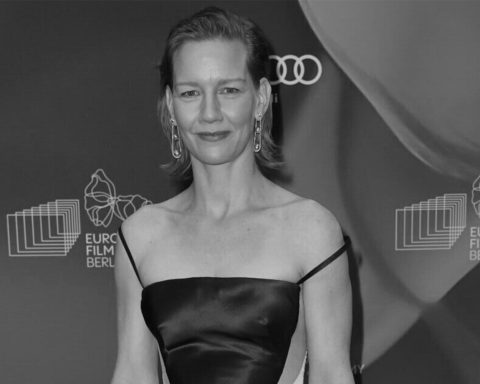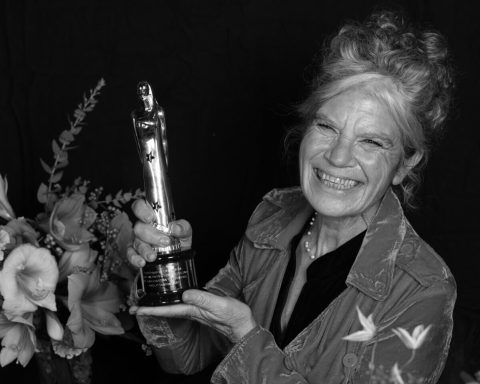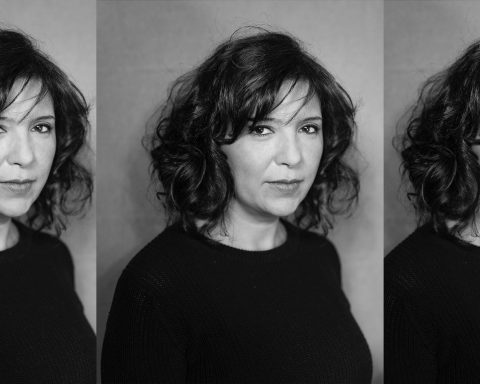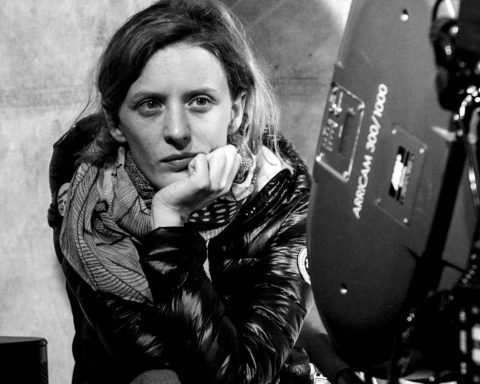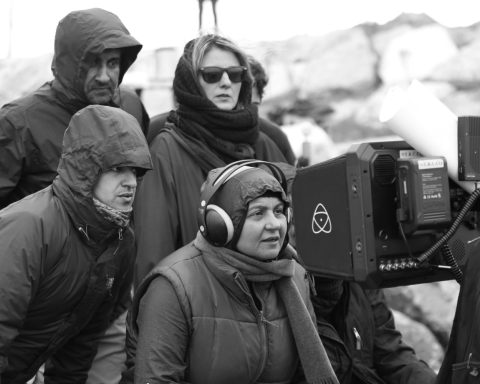Norwegian writer/director Maria Sødahl tells a very personal story – reflecting on how her own terminal diagnosis impacted her family – in her second feature Hope, which premieres on September 7 at the Toronto International Film Festival in the “Discovery” section. Sødahl, who graduated from the National Film School of Denmark in 1993, directed four shorts and also worked in casting. She directed her first feature “Limbo” in 2010. The story of a dysfunctional Norwegian expatriate family living in Trinidad won five Amanda awards in Norway and picked up Best Director Award at the Montreal World Film Festival in 2010. With “Hope,” she tells the story of Anja (Andrea Bræin Hovig), a successful choreographer, who lives with her companion Tomas (Stellan Skarsgård), a theater director, and their blended family. The day before Christmas, Anja is diagnosed with life-threatening brain cancer, the family’s life together breaks down and exposes neglected love.
Wendy Mitchell spoke to Sødahl in Olso in August 2019, ahead of “Hope”’s launch at TIFF. Thomas Robsahm produces for Motlys, in co-production with Zentropa Sweden, Film i Väst and Oslo Pictures. TrustNordisk handles sales.
Hope is inspired by your own experience, how did you know you were ready to tell this story?
Maria Sødahl: I didn’t know if I was ready or not. It’s a project which has been developed without my own will in a way. Quite a few years after my illness and treatment I really didn’t think I was able to work again, medically speaking I didn’t have the concentration. But I started trying to write an hour per day. I was trying to write about other stuff, but this experience just stood in the way. I had to deal with it.
I became so fascinated about what happened and studying myself and studying myself through my family. I thought, “How I can have a distance? How can I make this personal and not private? That’s the largest challenge.” To get that distance, but still be extremely honest was the most interesting part of going back and looking at the experience, the raw and naked brutality of things. But also the beauty.
The medical story is like a motor to this story, but it’s more about life and love, it’s not so much about death. It was also very interesting exploring what is modern love; something I think that makes the movie hopefully relevant for a lot of people.
How could you separate the character of Anja from yourself?
M.S.: I needed distance to the main character. For instance, I changed her profession and her partner’s profession. But it still had to be liberal passionate people, two persons needing that space. I also increased the age difference [between Anja and Tomas] – before my illness, I had started a different project with this theme [of a couple with an age gap]. It was an interesting theme, and it felt so good for this [story]. I just increased the age difference from ten years to twenty years.
I think that’s an interesting thing about writing autobiographical material – you have to go all the way, if it’s a hybrid you can feel it. The medical story here just works because it’s accurate. And on an emotional level, everything happened.
How did you cast Andrea?
M.S.: I was looking for someone unaffected and courageous, with a great emotional register. Who could portray a complex character with depth. And then Andrea came along, accompanied by great timing and sense of humour. She is somebody who fascinates me a lot and them as a couple, they worked so nicely together. It’s bit Bonnie and Clyde, petite and tall, feisty and phlegmatic – they make a great odd couple.
Andrea said this is the toughest project she’s ever done. She was exhausted, she put 120% into it. It’s not often you get a chance to do that 360-degree work. It’s a very vulnerable thing and, at the same time, it’s present. She’s in touch with all those layers. We talked a lot about that she’s not portraying me she’s making her own character. And I don’t have the answers although I’ve experienced it.
Tomas is quite a stoic character compared to Anja, was that harder to write?
M.S.: I think that character is very, very interesting. He’s contained in a way that makes you very curious what’s he’s actually thinking. He’s mirroring her in a way; when she goes bananas, he’s the audience. It’s like a thriller wondering when will he react. The crucial thing is that in such a situation of this existential crisis he’s not allowed to act. Nobody is allowed to act out in front of someone with a death sentence. I guess Stellan had challenges defending such a character as he’s more emotional and outgoing himself.
With such heavy themes, what was the mood like on set?
M.S.: We had unexpectedly much fun on the set. There were so many absurdities. Even in the most romantic or saddest scenes, there are really funny things about human peculiarities and inadequacies.
Do you see similarities with your first feature, Limbo?
M.S.: My first film Limbo has very little dialogue. Most of the work I’ve done before is about people communicate everything less verbally. This script has so much dialogue for Anja. She’s so frank and so honest it’s almost boring in a sense because there is little or no subtext (laughs). But you find a new layer when you do that and that’s been a big challenge for me. Also, when I did Limbo I used a lot of amateur actors. And in this film we cast real doctors, and amateur actor as the kids as well. Thematically, I guess both films deal with the conditions of love within a family.
What do you think this film is saying about marriage?
M.S.: That’s up to the audience. I think it’s not so interested in marriage as much as I’m interested in relationships, long or short. How those relationships develop through stages of life and how you look at that.
How did you think about the visual approach for Hope? Especially for a film set during the holidays you didn’t want it to look like a Christmas card.
M.S.: I had also worked with Manuel [Alberto Claro, DoP] on Limbo. We talked about finding the dynamics for every situation.
The heart of this movie is the family apartment, that’s where they come from and go back to all the time. It had to be full of life and feel real. We built that set at Trollhattan in a 350-square-meter apartment. And then outside of that heart, we had the vision to make it more like a road movie. You have the cold and dark winter weather, and the hospital with its bright, institutional lighting. This contrast with warm and cold and that energy it gives was something we talked about a lot.
As a female director working in the Norwegian film industry, have you always felt supported?
M.S.: No, in the very beginning [of my career] I think I was in a gap. I graduated from the Danish National Film School [in 1993] and it felt like a desert returning to Norway as there were no young producers. Nobody was interested in new female blood, new female directors. It was a very masculine era. In the ‘70s, there had been a lot of female Norwegian directors, but there weren’t in the ‘90s. But now, it’s a totally different scenario. I’m excited to see what happens with this next generation, who do things in different ways than what’s expected. Both artistically and thematically. But still, huge budgets don’t go to women, so it’s not without its challenges.
Who are your filmmaking inspirations?
M.S.: I first experienced Cassavetes’ films as a student, and that changed a lot in me. That’s still with me in a way, the idea that drama can be about middle-class issues, not a huge political story. He made it legitimate to tell your own stories. Jane Campion’s The Piano was the first movie where I really felt there was a difference [with a female director]. The way that she dealt with female sexuality, that was something very raw and honest. And right now, I love Kore-eda’s Shoplifters. I also find Maren Ade being an interesting voice as a director.
But I’m into literature just as much as films. For instance with Elena Ferrante, what part of humanity does she show which is so different and feels so unique and true that so many men and women can relate to it?
You’re married to another filmmaker [Hans Petter Moland], do you think you influence each other’s work?
M.S.: Obviously, we can’t work together; we support each other and we mirror each other a lot. We make very different work. Sometimes, we have similar tastes, but we also differ a lot in terms of tastes, leading to endless discussions.
What do you hope the audience experience of Hope will be?
M.S.: You experience things as an audience on so many levels. I wanted this movie to be something you can feel in your gut and make it a physical experience. There is an enormous drive in the movie; it’s pacey. There’s not a lot of time to contemplate while you are watching it… As a result, the audience will not be left in peace, but hopefully given a wake-up call. It offers an opportunity to reflect on the choices they make in their own lives. When the film is over.
What might be next? How can you follow this up?
M.S.: Maybe not a cancer movie. I’ve been thinking quite a lot about who is making movies about elderly people. I’m curious about what it’s like pushing eighty in our days, a fascination which might become a future story to tell.
First, my new project with the working title Man Watching deals with the painful challenges of being in your early twenties. When it’s all about searching for your identity. When naiveté and overweening confidence dominate. A phase of life I want to explore through a young European girl’s “educational journey” to Mexico. While travelling alone and meeting strangers, she finds herself experimenting on many levels, among her experiments is reinventing her own persona. She encounters situations that bring opportunities for incredible growth and devastating failure, losing grip of who she is.
The idea came about by reflecting on how young people move around today in a globalized world, compared to my own experience as a traveler in the mid-‘80s. I always subscribe to the idea, and the importance of “going out there”, both to get to know your own roots and in order to find out who you are.
It seems I have a project going on portraying women in their different stages of life.
Photo credit: Agnete Brun






